Estimated reading time: 11 minutes
Homesteaders can preserve pretty much any type of food through all sorts of food storage methods. Some of these methods, such as salt curing, have been used for centuries, while others are relatively new, such as freeze-drying.
Each of these food storage methods has different pros and cons. Not all food types work for each technique, so let's take a look at the top 15 methods and figure out which one is best.
Want to save this post for later? Click Here to Pin It on Pinterest!
15 Food Storage Methods
1. Canning
Canning is perhaps the most discussed food storage method, and it’s coming back into style as more people get interested in homesteading. When you can, you have two choices: water bath canning and pressure canning.
Water bath canning is for foods that are higher in acid. You can make pickles, jellies, jams, sauces, and more in a water bath canner.
Pressure canning is needed to can low acid vegetables and meat. If you want to can green beans or soups, you need a pressure canner.
Many foods are candidates for canning, such as:
- Tomatoes
- Strawberries – Sauce and Jam
- Raspberries
- Green Beans
- Peppers
- Cucumbers
- Potatoes
- Soups – Tomato, Chicken, Beef
- Broth
There are several resources online to get you started, such as this beginner’s guide to canning at home.
2. Dehydrating
One of the oldest forms of food storage is dehydration or drying. You have several ways to dry food, such as air drying, sun ovens, solar dehydrators, baking sheets in the oven, and commercial dehydrators.
Dried foods have some perks. They’re perfect when you’re low on storage space. You can dehydrate vegetables and soup mixes that are reconstituted with some hot water.
I love to dehydrate blueberries and use them in blueberry pie later. They plump up and taste just like fresh blueberries. Another fun thing to dehydrate is marshmallows – just like the marshmallows in cereal!
So, what can you dehydrate?
- Fruits
- Vegetables
- Jerky
- Herbs
Here is some more information on how to dehydrate food. For those of you with a garden, check out Foodal’s ultimate guide to dehydrating your garden’s bounty.
3. Freezing
Freezing is a modern method of preservation that holds up the flavors and textures better than other food storage methods. Frozen foods taste just like fresh, and you don’t need special equipment to freeze. Most vegetables need to be blanched or cooked before you freeze them to guarantee the best flavor and quality.

Fruits can be frozen as is, but they also can be frozen with sugars to extend storage life. One negative to consider, as a prepper or someone who wants to have a stockpile, is that having a freezer food storage requires electricity. As soon as the power goes out for an extended time, you'll lose all of the food you've saved, and that could be the loss of thousands of dollars.
You can freeze anything from fruits and vegetables to soups and meatballs. Some gardeners even freeze their tomatoes so they can make their tomato sauce later in the fall when the temperatures get cooler.
Before you try freezing food, be sure to read these 6 basic guidelines for freezing food.
4. Freeze Drying
For a long time, freeze-drying wasn’t an option for at-home food preservers, but now you can purchase home freeze-drying units. Harvest Right is based out of Utah, and they’re taking the homesteader world over by offering affordable units. Now, those units are still thousands of dollars, but you have to understand for years this wasn’t even an option.
Freeze-drying allows you to preserve a vast range of food. You can even freeze-dry milk, cream-based soups, and full meals. It makes storing meat, vegetables, fruits, seafood, and more so easy. However, the cost of a freeze drier is steep, so it's cost-prohibitive for many people.
To learn more, check out this guide to freeze-drying at home.
5. Vacuum Sealing
Vacuum sealing is one of my favorite picks for saving small batches for food or leftovers. It stops freezer burn, letting you freeze items for much longer than average. Using a vacuum sealer is easy. All you need is the vacuum sealer, bags, and a place to store them once sealed.
Unless you dehydrate the food first, you do need to keep it in the freezer so it won’t go bad. Using a vacuum sealer is one of my favorite ways to store dehydrated foods for long term or camping, and it saves me hundreds of dollars.
Before you get one, be sure to read Vacuum Sealers – What You Need to Know Before You Buy.
6. Root Cellars
Cold storage, or root cellars, is one of the most natural home food preservation options. Root cellars are cold, damp storage, but some people use their basement. Or you can build a mini root cellar.
This method of food storage is simple, and it just requires you to keep the right temperature and humidity in the space, as well as packing the vegetables correctly.
Not all vegetables can be stored in a root cellar. A few good choices are:
- Potatoes
- Carrots
- Cabbages
- Apples
- Onions
- Garlic
- Beets
- Parsnips
- Turnips
Here's a complete list of foods you can store in root cellars. And here's a guide to vegetable storage in a root cellar.
7. Pickling
Who doesn’t love pickled foods? When you think of pickling, you think of the classic Dill pickles or bread and butter pickles, but pickling doesn’t just end there.
Pickling is an easy process. It involves adding vinegar, spices, and putting it all into a jar. Then, using a water bath canner, you process the jars, or you can make pickles in the refrigerator. The liquid prolongs the life of the food you want to pickle.
Here's exactly how to make pickles. But don’t feel confined to just making regular picks. Try pickling jalapenos, banana peppers, radishes, green beans, and other vegetables.

8. Jams & Jellies
You might not think that making jams and jellies is a food storage method, but it is. I had to include it separate from canning because making jellies and jams isn't just canning, it's an art.
You can let your creativity run wild; there are so many ways to make jams and jellies. The next time you have a large surplus of fruits or vegetables, think about making a jelly instead. It allows you to enjoy them for months to come in a different context.
Which one is better – jams or jellies? It’s just a matter of personal preference. Jellies are removed from the process, making it a bit larger with an extra step or two. Jams might have some chunks of fruit. Both are delicious; we eat both regularly.
A few jams and jellies that I like to make:
- Strawberry jam
- Grape jelly
- Mixed berry jam
- Tomato Jam
- Watermelon jelly
- Apple cinnamon jelly
- Carrot jam
Here is how to make jam and how to make jelly.
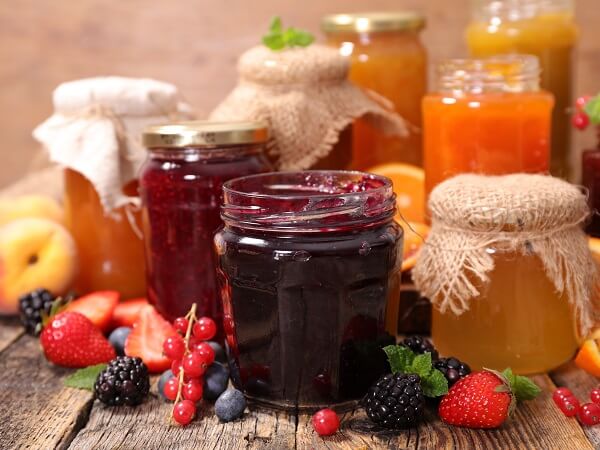
9. Salting Food
Salting food is an old-fashioned style of food storage that goes back centuries to before refrigeration was invented. People salted their meats, primarily, but you can also salt cure eggs, which is delicious.
The basic idea behind salting food is that you cover the meat in a lot of salt and then hang the meat somewhere to cure. Barns, basements, and cellars are favorite picks for hanging salted food. It only works if you live somewhere that has temperatures cold enough that meat can hang without rotting.
Here is how to preserve meat with salt and how to make salt-cured egg yolks.
10. Smoking Meat
Smoking is another old-fashioned style of food storage, but it's still popular today. Some people have dedicated smokers on their property for smoking the meat and fish they catch. If you decide to raise your meat or hunt, it's a great skill to have. You can incorporate so many flavors into your meat by smoking them.
Smoking meats work in two ways – hot smoking or cold smoking. You can do both methods with the same food, but the difference is the temperature. Hot smoking needs a closed box to hold all of the smoke inside, but hot smoked meat will go bad faster when left out. Cold smoke is done at cooler temperatures for a longer time, but it's best for long-term storage.
Here is how to use salt and smoke to cure meat and fish.
11. Fermentation
Natural fermentation turns low acid foods into high acid foods, giving them a longer shelf life, or you can use a water bath canner for even longer storage. Fermentation uses salt, a starter, or whey to ferment the food which betters the nutritional content.
Lactic acid and microbes take over, creating unique flavor profiles and textures. You can use fermentation with vinegar, sauerkraut, almost any vegetable, yogurt, cheese, kombucha, and more.
Even though fermentation seems complicated, it's one of the easiest methods. Once you understand the right starters and how to make your starter, fermenting food takes little time. The most substantial bulk of the time is spent preparing the food to be fermented.
To learn more about fermentation, check out this beginner’s guide to fermentation along with these 10 fermented foods you can easily make at home.
12. Sugar Preservation
So you know that salt can act as a preservative, but did you know sugar can be used as well? Sugar helps to preserve food and does a great job of it. You can preserve fruit rinds in sugar for a yummy treat. To make candied fruit rinds, you have to dip the peels into massive amounts of sugar and cook them until the sugar crystallizes.
Here is some more information on preserving with sugar.
13. Making Jerky
Most people would put making jerky under dehydrating, but there are other ways to make jerky, such as hanging it to dry. Jerky is a beloved snack throughout the world, and it's a prepper's and hiker's best friend.
All of the liquid and water has been removed from the meat, leaving a dried strip of beef. It doesn't have to be beef, but that's a common pick. Venison always makes great jerky. Here is a delicious beef jerky recipe.
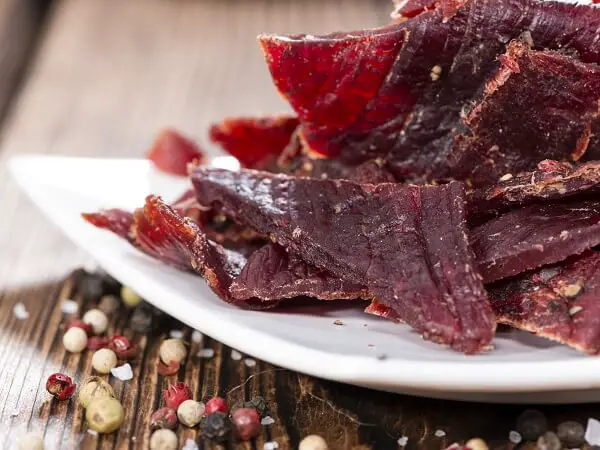
14. Immersion in Alcohol
Alcohol draws out water in food, which stops microbe growth. You can submerge small amounts of food in any hard liquor of your choice, allowing it to be stored indefinitely.
In general, immersing food in alcohol is best saved for making flavor extracts and preserving high acid foods, like fruits. Herbs and fruits soaked in liquor create rich extracts that you can use in cooking and baking. Try making mint, lemon, almond, and vanilla extracts.
Here are some homemade extract recipes, and here's how to make homemade liqueurs.
15. Making Cheese
People don’t typically think of cheese as a food storage method, but the dairy world has changed since the introduction of pasteurization and homogenization.
Years ago, when small families had their dairy cows, they knew that milk has full times and limited times. Milk was most plentiful after the mothers calved in the spring and early summer. These cows had access to an abundance of grass throughout the late spring, summer, and first fall months. Some of the time, they couldn't drink the milk fast enough!
So, they learned how to make cheese from the milk. Cheese is essentially a form of fermentation when the bacteria in the milk counteract to make cheese. Then, they would have an abundance of cheese in the winter because cheese takes months, even years, to cure for the right flavor properly.
Here's how to make simple farm-style cheese at home.
So Which Food Storage Method is Best?
This list is far from exhaustive; dozens of food preservation methods have fallen in and out of fashion over the centuries. The question is – which food storage method is best?
While freeze-drying is excellent because of its versatility and unlimited choices, it's cost-prohibitive for most people. Therefore, in my opinion, canning is the best food storage method. It has the most extensive range of food: fruits, vegetables, meats, and more, and the storage shelf-life is multiple years, perfect for prepping.
Like this post? Don't forget to Pin It on Pinterest!



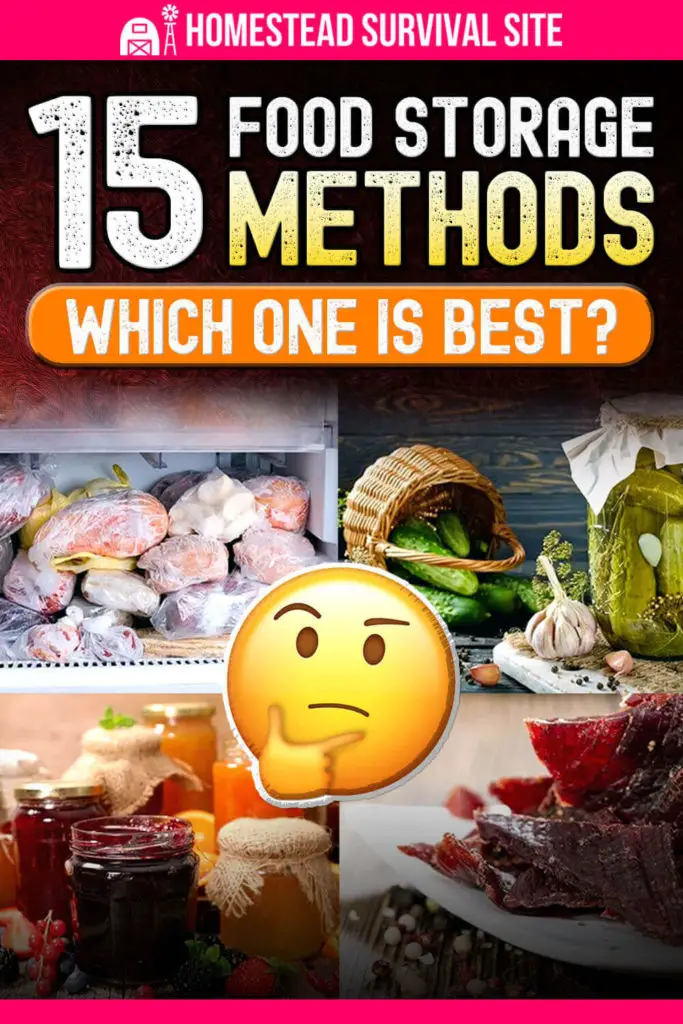


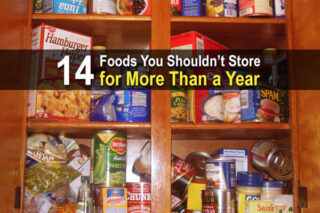

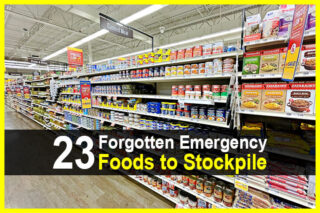

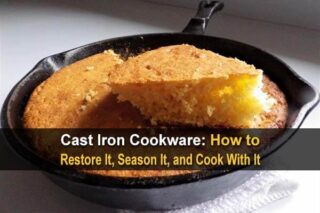


Nice list, and good info. However, the return of canning as a preservation method needs one caveat. I have eaten home canned foods that were many years old. But the new canning lids are of much thinner metal, with much less sealing gasket material. The result is canned food that simply gives up its seal after a couple years. If you can, check your seals often, quarterly at least.
Good advice, thanks!
I enjoyed this article. My father always pickled hard boiled eggs.It makes them turn yellow but they are just as tasty overtime as a snack or a side dish.
In Africa our elders used to say they were digging a hole in the ground underneath the tree and put things like milk and another method is put things inside the river with the skin of an animal.